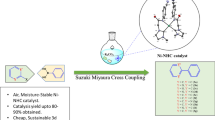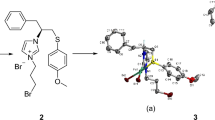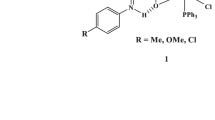Summary
Diazadienes (DAD) (RN=CR′CR′=NR with R′=H or Me and R=n-,i- ort-alkyl, aryl oro,o′-substituted aryl) easily form the thermally inert title compounds [(DAD)-Ru(CO)2I2] (2). Their stereochemistry is unambiguously derived from1H-n.m.r. and i.r. data. One of the complexes (2h) cocrystallizes with the free diazadiene (1h) in a 1∶1 molar ratio. An x-ray diffraction study, which allows a comparison of the free and bound diazadiene. was performed with the monoclinic crystal and gave the following cell parameters: space group C 2/c, a=2237.0(5), b=1017.4(3) and c=1824.9(4) pm, β=105.13(2)°, Z=4. From 2781 observed reflections 293 parameters were refined, leading to a final R-value of 0.0346 (Rw=0.0340). The tilting of thep-tolyl group is a consequence of an intra-ligand repulsion R/R′, the R-conformation being almost equal in the (E,E,E)-shaped molecule (1h) (68°) and the (E,Z,E)-chelate in (2h) (72°). Complexes (2) are photolabile (with loss of CO), and on reduction they lose iodide, thus offering selective ways for the exchange of π-acceptor or σ-donor ligands for precatalyst formation.
Similar content being viewed by others
References
H. tom Dieck, W. Kollvitz and I. Kleinwächter,Organometallics, in press (1986).
H. tom Dieck and A. Kinzel,Angew. Chem., 91, 344 (1979);Int. Ed. Engl, 18, 324 (1979).
H. tom Dieck, A.-M. Lauer, L. Stamp and R. Diercks,J. Mol. Catal., in press (1986); R. Diercks, L. Stamp, J. Kopf and H. tom Dieck,Angew. Chem., 96, 891 (1984);Int. Ed. Engl, 23, 893 (1984); R. Diercks and H. tom Dieck,Chem. Ber., 118, 428 (1985); R. Diercks, L. Stamp and H. tom Dieck,ibid., 117, 1913 (1984).
H. tom Dieck, J. Dietrich,Angew. Chem., 97, 795 (1985);Int. Ed. Engl., 24, 781 (1985);Chem. Ber., 117, 694 (1984); H. tom Dieck and R. Diercks,Angew. Chem., 95, 801 (1983);Int. Ed. Engl., 22, 778 (1983); (S) 1983, 1138–1146.
M. Brockmann, H. tom Dieck and J. Klaus,J. Organometal. Chem., 301, 209 (1986).
H. tom Dieck and A. Orlopp,Angew. Chem., 87, 246 (1975);Int. Ed. Engl, 14, 251 (1975).
H. W. Frühauf and G. Wolmershäuser,Chem. Ber., 115, 1070 (1982); H. W. Frühauf, A. Landers, R. Goddard and C. Krüger,Angew. Chem., 90, 56 (1978); Int. Ed. Engl., 17, 54 (1978); H. W. Frühaufet al., J. Organometal. Chem., in press (1986).
G. van Koten, K. Vrieze,Adv. Organometal. Chem., 21, 152 (1982) and refs. therein.
W. Hieber and H. Heusinger,J. Inorg. Nucl. Chem., 4, 179 (1957).
R. L. Bennett, M. I. Bruse and F. G. A. Stone,J. Organometal. Chem., 38, 325 (1972).
C. F. J. Barnard, J. A. Daniels, J. Jeffery and R. J. Mawby,J. Chem. Soc., Dalton Trans., 953 (1976).
S. C. Grocott and S. B. Wild,Inorg. Chem., 21, 3535 (1982).
W. Hieber and P. John,Chem. Ber., 103, 2161 (1970).
R. J. Irving,J. Chem. Soc., 2879 (1956).
H. van der Pool, G. van Koten and K. Vrieze,Inorg. Chem., 19, 1145 (1980).
L. Stamp,Ph.D. Thesis, Univ. of Hamburg, 1985.
H. tom Dieck, W. Kollvitz and I. Kleinwächter,Inorg. Chem., 23, 2685 (1984).
H. tom Dieck, H. Bruder, K. Hellfeldt, D. Leibfritz and M. Feigel,Angew. Chem., 92, 395 (1980);Int. Ed. Engl., 19, 396 (1980).
M. Svoboda, H. tom Dieck, C. Krüger and Y.-H. Tsay,Z. Naturforsch., 36b, 814 (1981); H., tom Dieck, M. Svoboda and Th. Greiser,ibid., 36b, 823 (1981); distances in (DAD)2Ni complexes are: d(C=N) 132 and 134 pm d(C-C) 140 and 137 pm, respectively.
M. A. Bennett, M. I. Bruce and T. W. Matheson, in G. Wilkinson, F. G. A. Stone and E. W. Abel, (Eds.),Comprehensive Organometallic Chemistry, Pergamon Press, Oxford 1982, Vol. 4, p. 691ff.
W. Majunke, D. Leibfritz, Th. Mack and H. tom Dieck,Chem. Ber., 108, 3025 (1975).
H. tom Dieck, Th. Mack, K. Peters and H.-G. von Schnering,Z. Naturforsch., 38b, 568 (1983).
I. Kleinwächter,Ph.D. Thesis, Univ. of Hamburg, to be submitted in 1986.
W. Kollvitz,Ph.D. Thesis, Univ. of Hamburg, 1984.
I. W. Renk and H. tom Dieck,Chem. Ber., 105, 1403 (1972).
W. Rohde, L Kleinwächter and H. tom Dieck,Z. Naturforsch., submitted for publ.
M. Brockmann, H. tom Dieck and I. Kleinwächter,J. Organometal. Chem., submitted for publ.
P. Main, S. E. Hull, L. Lessinger, G. Germain, J. Leclerq and M. M. Woolfson, MULTAN-78. A computer program system for the automatic solution of crystal structures from x-ray diffraction data. Universities of York, U.K., and Louvain-la-Neuve, Belgium, 1978.
G. M. Sheldrick, SHELX-76. Programs for crystal structure determination, Cambridge, England, 1976.
E. Keller, Schakal. Ein Fortran-Programm for die graphische Darstellung von Molekülmodellen,Chiuz., 14, 56 (1980).
Author information
Authors and Affiliations
Additional information
For Part IV see Ref. 1, Part III see Ref. 17; Part II and I, seeTransition Met. Chem., 7, 154 (1982) and6, 185 (1982), respectively.
Rights and permissions
About this article
Cite this article
Dieck, H.t., Kollvitz, W., Kleinwächter, I. et al. Ruthenium complexes with diazadienes, Part V(1).Cis-Dicarbonyl-1,4-diaza-1,3-diene-trans-diiodoruthenium Complexes; synthesis, properties and the crystal structure of [(DAD)Ru(CO)2I2] · DAD (DAD=p-tolyl-N=CMe-CMe=N-p-tolyl). Transition Met Chem 11, 361–366 (1986). https://doi.org/10.1007/BF01225982
Received:
Issue Date:
DOI: https://doi.org/10.1007/BF01225982




